![]()
![]()
![]()
Use LEFT and RIGHT arrow keys to navigate between flashcards;
Use UP and DOWN arrow keys to flip the card;
H to show hint;
A reads text to speech;
63 Cards in this Set
- Front
- Back
|
Horse
c. 15,000-10,000 BC Lascaux, France |
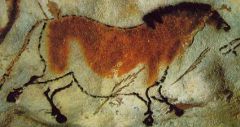
t/d/l
|
|
|
Stonehenge
c. 2000 bc |

t/d
|
|
|
Statuettes from the Temple of Abu
c. 2650 bc Sumeria |
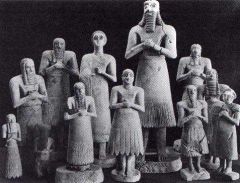
t/d/l
|
|
|
Stele of Hammurabi
c. 1780 bc Sumeria (Louvre) |

t/d/l
|
|
|
Great Pyramids of Gizeh
c.2500 |

t/d/l
|
|
|
Menkaure and His Queen
c. 2500 bc Museum of Fine Arts, Boston |
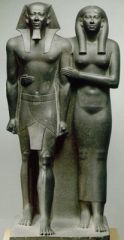
t/d/l
|
|
|
The Great Sphinx
c. 2500 B.C. Gizeh |

t/d/l
|
|
|
Queen Nefertiti
c. 1350 B.C. |
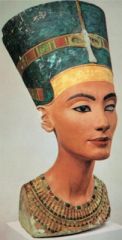
t/d/l
|
|
|
Snake Godess
c. 1650 B.C. Crete |
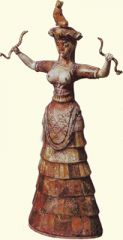
t/d/l
|
|
|
The Toreador Fresco
c. 1500 B.C. Crete |
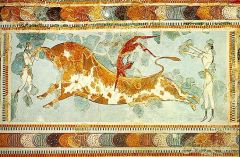
t/d/l
|
|
|
Octopus Vase
c. 1500 B.C. Crete |
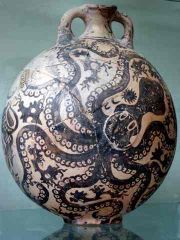
t/d/l
|
|
|
Lioness Gate
c. 1250 B.C. Mycenae, Greece |
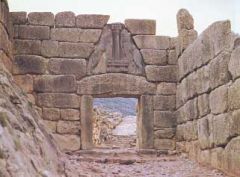
t/d/l
|
|
|
Dipylon Vase (grave monument)
c. 740 B.C. *geometric style Athens |
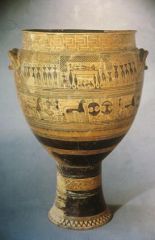
t/d/l
|
|
|
Exekias
Dionysos, a Satyr and a Maenad (MEEN-ad). Attic black-figured amphora c. 540 BC |

a/t/d/l
|
|
|
Exekias
Dionysos in a Boat [according to a Homeric hymn, the god of wine had once been abducted by Etruscan pirates. He thereupon caused vines to grow all over the ship and frightened his captors until they jumped overboadrd and were turned into dolphins. We see him on his return journey] c. 540 B.C. Interior of an Attic black-figured kylix |
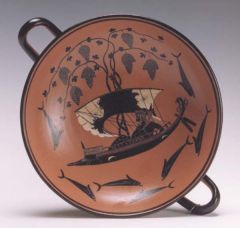
t/d/l
|
|
|
Euphronios
Hercules Wrestling Antaeus, Attic red-figured krater c.510 bc |
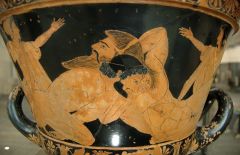
a/t/d/l
|
|
|
Douris
Eos (Aurora)and Memnon, interior of Attic red-figured kylix (The godess of the dawn holding the body of her son, killed and stripped of his armour by Achilles) c. 485 b.c. |
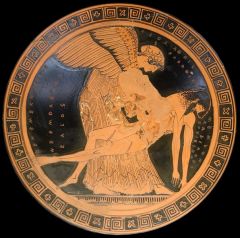
a/t/d/l
|
|
|
Kouros
c. 600 bc One of the first large freestanding stone images of the human form in world history Metropolitan |

t/d/l
|
|
|
Anavysos Kouros
c. 525 bc Athens *Note the "Archaic smile" which occurs throughout sixth-century Greek sculpture |

t/d/l
|
|
|
Kritios
Kritios Boy c. 480 bc from the Acropolis, Athens One of the earliest examples of the contraposto pose. "The entire figure seems so alive that the Archaic smile, the "sign of life" is no longer needed. It has given way to a serious expression characteristic of the early phase of Classical sculpture (or, as it is often called, the Severe Style). Once Greek statue was free to move, as it were, it became free to think, not merely to act. |
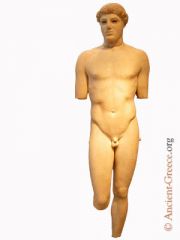
t/d/l
|
|
|
Dying Warrior
c.480 bc east pediment of the Temple of Aphaia, Aegina |
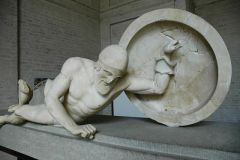
t/d/l
|
|
|
Polykleitos (pol-i-KLEE-tuhs)
Doryphoros (Spearbearer) Roman copy of original from c. 450 bc Museo Archeologico Nazionale, Naples |
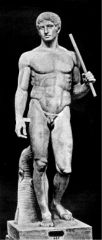
a/t/d/l
|
|
|
Riace Warrior A
c. 450 bc Museo Archeologico, Reggio Calabria |

t/d/l
|
|
|
Myron
Diskabolos (Discus Thrower) Roman copy of original from c. 450 bc Museo delle Terme, Rome |
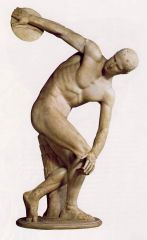
t/d/l
|
|
|
Dying Niobid (nye-O-bid)
c. 450 bc * The earliest known large female nude in Greek art. In the Niobid, human feeling is for the first time expressed as eloquently in the features as in the rest of the body. What separates the Niobid from the world of archaic art (see dying warrior from Aegina) is summed up in the Greek word pathos. Pathos means suffering, but particulary suffering conveyed with nobility and restraint, so that it touches rather than horrifies us. |
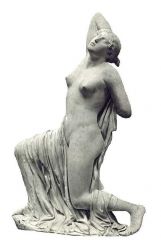
t/d/l
|
|
|
Athena Nike
c. 410 bc from the balustrade of Kallikrates's Temple of Athena Nike, Akropolis, Athens The goddess removes her sandal before stepping on her altar |

t/d/l
|
|
|
Apollo Belvedere
c. 340 bc Musei Vaticani, Rome |

t/d/l
|
|
|
Praxiteles (prak-SIT-l-eez)
Hermes c. 340 bc Archaeological Museum, Olympia |
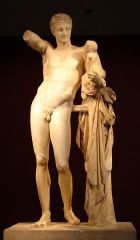
a/t/d/l
|
|
|
Praxiteles (prak-SIT-l-eez)
Aphrodite of Knidos Roman copy of original c. 340 bc Vatican Museums, Rome |

a/t/d/l
|
|
|
Polyeuktos
Demosthenes (di-MOS-thuh-neez) c. 280 bc Copenhagen Athenian statesman and orator, He sought to preserve his city's freedom and to establish an alliance against Macedon, in an unsuccessful attempt to impede Philip's plans to expand his influence southwards by conquering all the Greek states. After Philip's death, Demosthenes played a leading part in his city's uprising against the new King of Macedon, Alexander the Great. However, his efforts failed and the revolt was met with a harsh Macedonian reaction. |
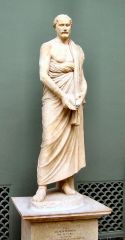
a/t/d/l
|
|
|
Nike of Samothrace
c. 200 bc Louvre |
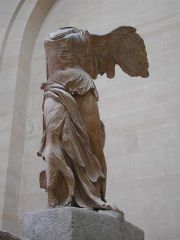
t/d/l
|
|
|
Venus de Milo
c. 135 bc Louvre |

t/d/l
|
|
|
Laocoon Group
c. 150 bc Musei Vaticani Laocoön warned his fellow Trojans against the wooden horse presented to the city by the Greeks. In the Aeneid, Virgil gives Laocoön the famous line Equo ne credite, Teucri / Quidquid id est, timeo Danaos et dona ferentes, or "Do not trust the Horse, Trojans / Whatever it is, I fear the Greeks even bearing gifts." This line is the source of the saying: "Beware of Greeks bearing gifts." The Trojans, according to Virgil, disregarded his advice, however, and were taken in by the deceitful testimony of Sinon; in his resulting anger Laocoön threw his spear at the Horse. Poseidon, who was supporting the Greeks, at this moment sent sea-serpents to strangle Laocoön and his two sons, Antiphantes and Thymbraeus |
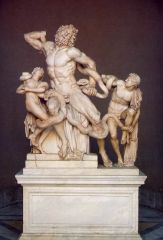
t/d/l
|
|
|
Temple of Hera I
c.550 bc Paestum, Italy |
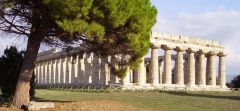
t/d/l
|
|
|
Temple of Aphaia
c. 500 bc Aegina |

t/d/l
|
|
|
Temple of Hera II ("Temple of Poseidon")
c. 460 bc Paestum, Italy |
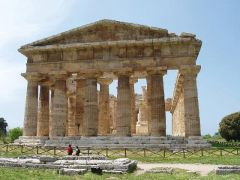
t/d/l
|
|
|
Iktinos and Kallikrates (kuh-LIK-ruh-teez)
The Parthenon 448-432 bc Akropolis, Athens |
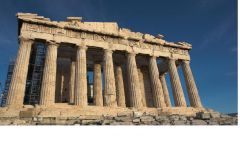
a/t/d/l
|
|
|
Kallikrates
Temple of Athena Nike c. 425 b.c. Akropolis, Athens |

a/t/d/l
|
|
|
Venus of Willendorf
c. 28,000-25,000 bc Vienna |

t/d/l
|
|
|
Plastered Skull, Jericho
c. 7000 bc Jordan |
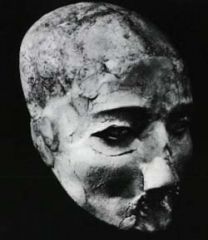
t/d/l
|
|
|
Female Head, from Warka
c. 3500 bc Baghdad |
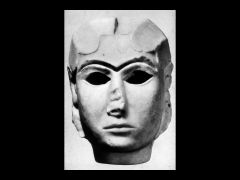
t/d/l
|
|
|
Head formerly believed to be of the God Abu
c. 2650 bc Baghdad |
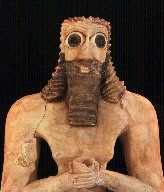
t/d/l
|
|
|
Head of an Akkadian Ruler
c. 2200 bc Baghdad |
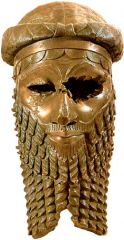
t/d/l
|
|
|
Winged Human-Headed Bull
c.720 bc Assyria |

t/d/l
|
|
|
People, Boats, and Animals
c. 3200 bc Hierakonpolis |
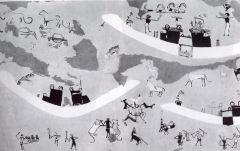
t/d/l
|
|
|
Palette of Narmer (back and front)
c. 3000 bc from Hierakonpolis Cairo |
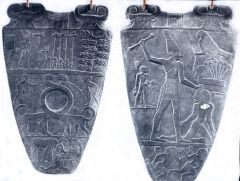
t/d/l******************
|
|
|
Step Pyramid at Saqqara
c.2650 bc Saqqara |
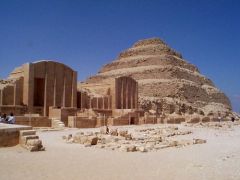
t/d/l
|
|
|
Khafre
c. 2500 Gizeh |

t/d/l
|
|
|
Tutanknamen burial mask
c. 1350 |
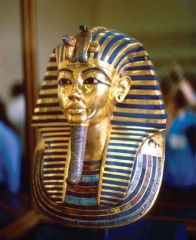
t/d
|
|
|
Temple of Ramses II
1257 bc |
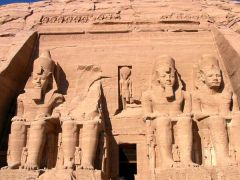
t/d
|
|
|
Lyre Player, from Keros
c. 2000 bc |
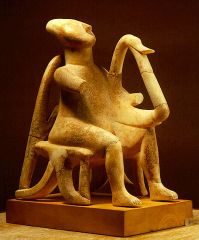
t/d
|
|
|
Psiax
Hercules Strangling the Nemean Lion, Attic black-figured amphora c. 525 Brescia, Italy |

a/t/d/l
|
|
|
Palace at Knossos
c. 1500 bc Crete |
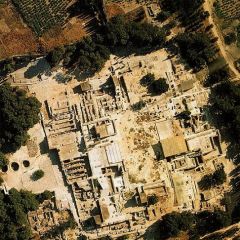
t/d/l
|
|
|
Kore, from Chios
c. 520 bc |
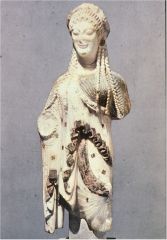
t/d
|
|
|
Kore
c. 650 bc Louvre |

t/d/l
|
|
|
Funeral mask from the royal tombs of Mycenae
c. 1500 |
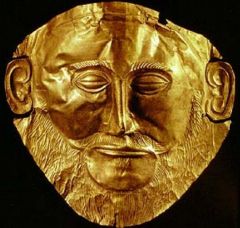
t/d/l
|
|
|
Charioteer of Delphi
c. 470 bc |
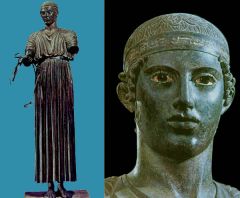
t/d
|
|
|
Apollo, from the west pediment of the Temple of Zeus at Olympia
c. 460 bc |
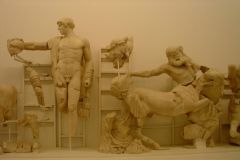
t/d/l
|
|
|
Three Goddesses, from the east pediment of the Parthenon
c. 435 Akropolis, Athens |

t/d/l
|
|
|
The Erechtheum
c. 410 bc Akropolis, Athens |

t/d/l
|
|
|
Lysippus
Apoxyomenos (Scraper) c.340 |
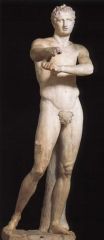
a/t/d
|
|
|
Altar of Zeus and Athena, Pergamon
c. 175 bc |
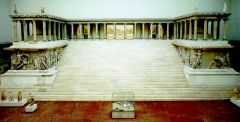
t/d/l
|
|
|
Apollonius ?
Seated Boxer c. 50 bc |
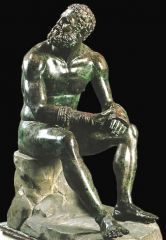
a/t/d
|

